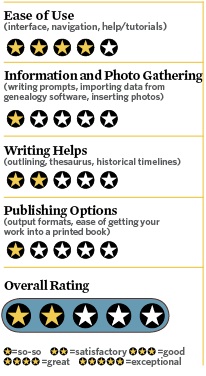Sign up for the Family Tree Newsletter Plus, you’ll receive our 10 Essential Genealogy Research Forms PDF as a special thank you!
Get Your Free Genealogy Forms
"*" indicates required fields
Ease of use
|
If the prospect of writing your life story (or your ancestors’) seems intimidating, Personal Historian software is designed to make the job less daunting. The program helps you break down a writing project into small pieces that you can complete in any order. Once you’re finished, it combines everything into a narrative, complete with a table of contents and index.
Before beginning, you’ll want to read the Getting Started guide from the Help menu. Press F1 from anywhere in the program for context-sensitive help, and view a video tutorial at www.personalhistorian.com/support/tutorials.aspx.
Information and photo gathering
Instead of starting your stories from scratch, you can use data you’ve already organized using genealogy software (Family Tree Maker 2006 and earlier, RootsMagic, Legacy or Personal Ancestral File 5) or import a GEDCOM file from another program. Just select the main person and any relatives whose details you want to include. Personal Historian doesn’t import all of the information that would help you write a story, though: You get dates and places, but not notes, quoted text, document images or photos. The software imports only one source per event and doesn’t bring in general notes or sources applied to a person.
Writing helps
Personal Historian provides “LifeCapsules”—historical events organized in 19 categories, including African-American History, British History, Canadian History, Epidemics, Inventions and US History. You select categories and events relevant to your subject’s life.
For example, if you’re writing about a farmer in the early 19th century, pertinent events in the Inventions category might include Cyrus McCormick’s reaper in 1831 and John Deere’s steel plow in 1837. The events databases help you put your subject’s life in historical context, but the program doesn’t include a series of questions to jog your memory.
The program treats each event, such as a census record or a will imported from your genealogy software, or a LifeCapsules event, as a separate story. You can create an outline for each story before writing about it. Frustratingly, though, you can’t create an outline for your entire personal history or easily integrate multiple events into one story.
Publishing options
Personal Historian combines all the topics (“stories”) you’ve written about into a narrative with a cover page, table of contents and an index. You can preview the whole book before printing it and save the report as an RTF file that you can edit in a word processor. Names and places to be indexed do not have embedded codes, so editing the report could mess up the page numbers cited in footnotes. You’re also supposed to be able to save the book as a PDF file (though that option didn’t work in the prerelease version I tested).
The verdict
The philosophy behind Personal Historian is good—breaking up a big family history writing project into small pieces is a practical approach. But for me, the software takes that approach too far: Writing about individual events one by one makes it hard to combine everything into a coherent narrative.

From the January 2012 issue of Family Tree Magazine
More great genealogy resources from Family Tree Magazine:
ADVERTISEMENT




